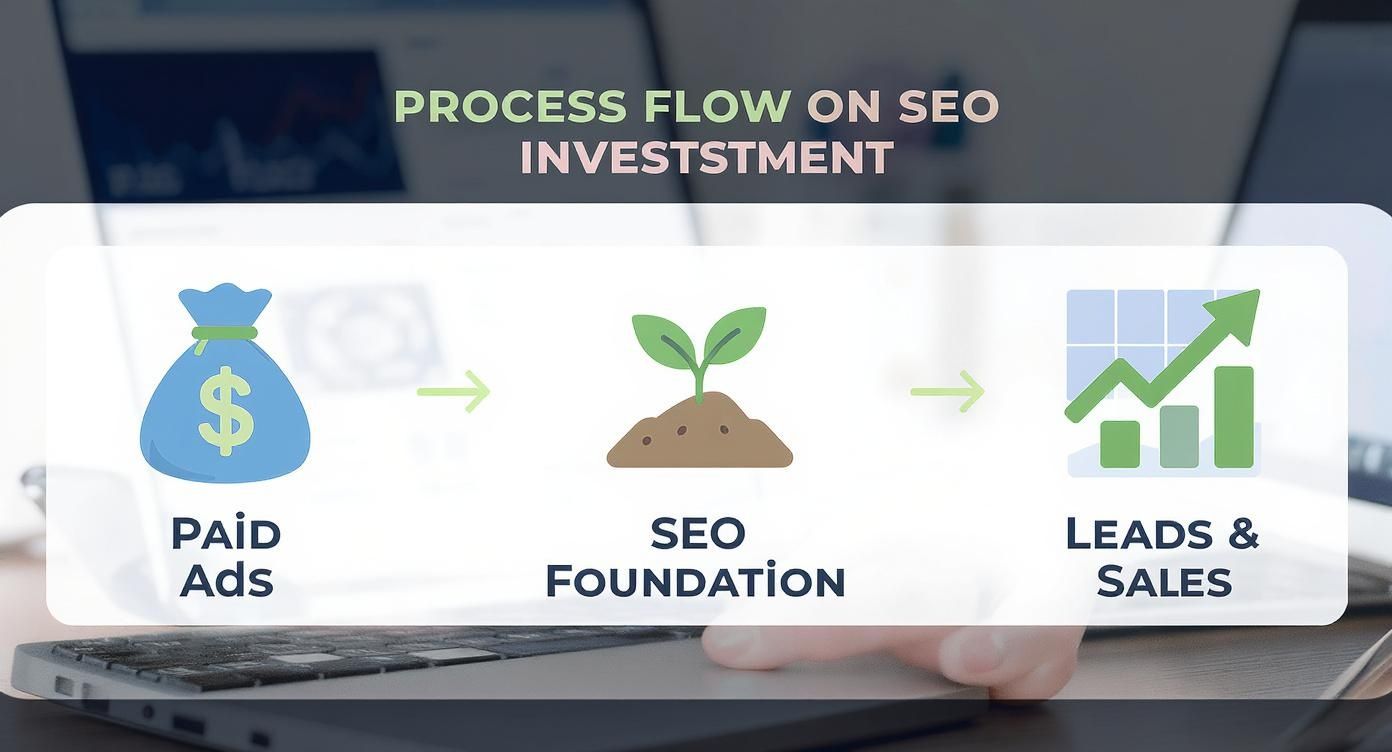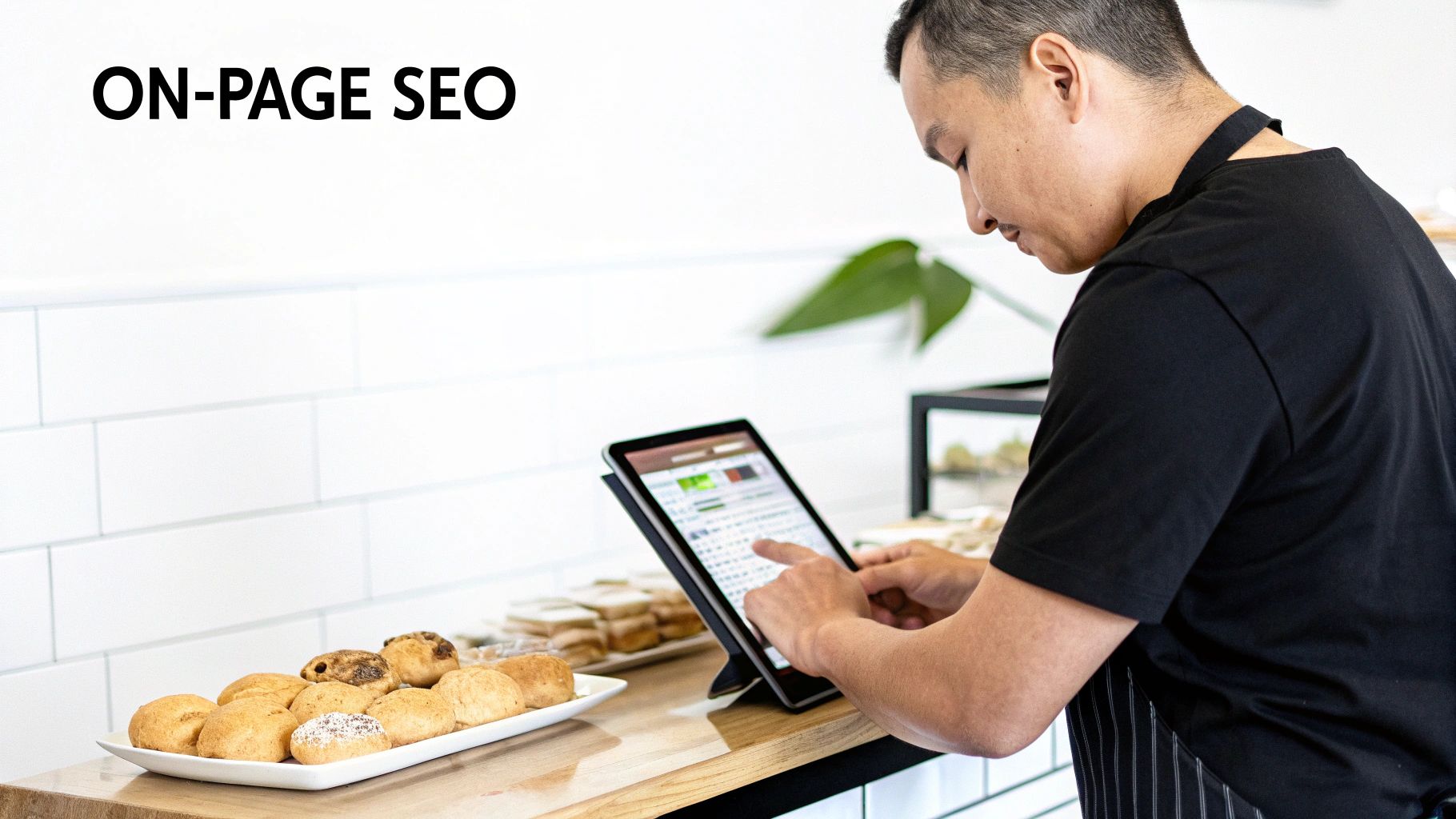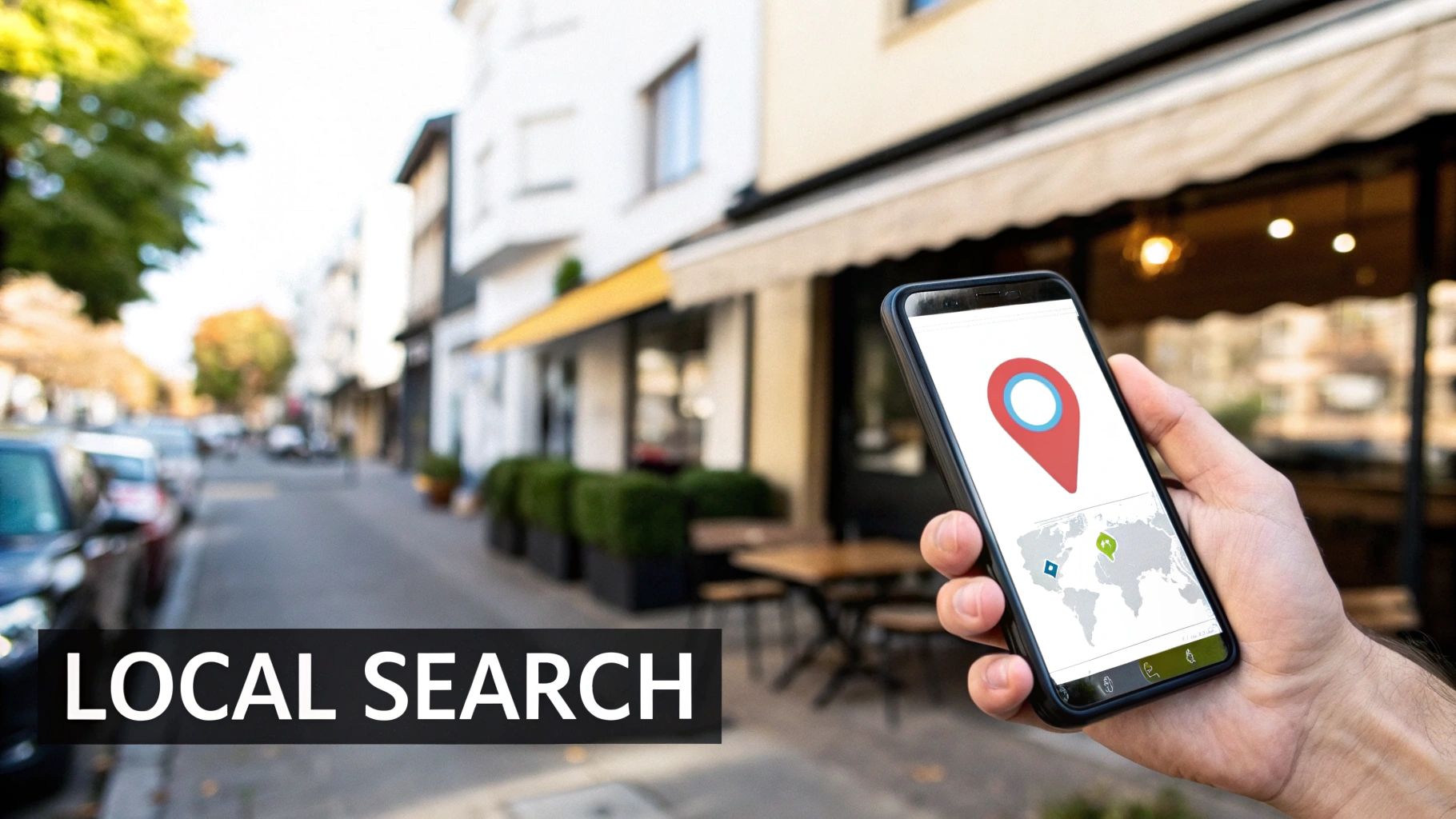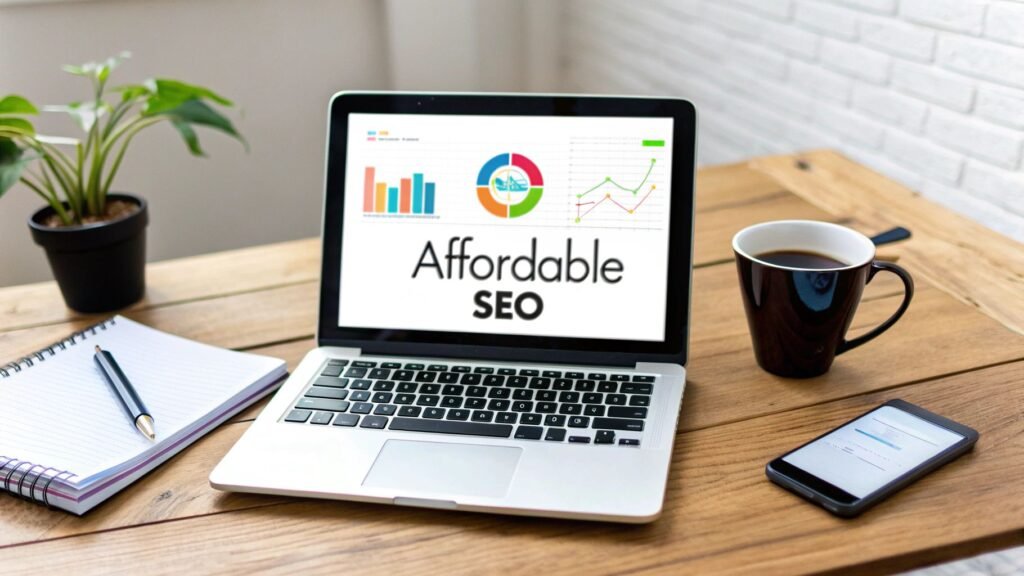Smart, affordable SEO is all about building a digital asset that works for you, day in and day out. It’s not about quick, temporary wins; it's about putting strategic, high-impact tactics in place that deliver a solid, long-term return on your investment. For a local business, this is how you connect with customers who are already looking for exactly what you offer.
Why Smart SEO Is Your Best Marketing Investment
For any small Aussie business, the marketing budget is a constant balancing act. You have immediate needs but also long-term growth goals. It’s incredibly tempting to just throw cash at paid ads for a fast traffic spike, but that’s like renting an audience. The second you stop paying, your visitors vanish.
This is where a smart, affordable SEO strategy offers a completely different kind of value.
Instead of just paying for clicks, you're building something permanent. Every blog post you optimise, every page you improve, and every positive local review you get becomes a piece of your online real estate, working for you 24/7. It creates a sustainable engine for bringing in new leads.
Think of it this way: you're owning your marketing channel instead of constantly leasing it from Google.
Before you spend another dollar, it's worth weighing up where that money is best spent. Foundational SEO provides lasting value, while paid ads offer instant visibility at a recurring cost.
DIY SEO vs Paid Ads Where to Invest Your First Dollar
| Factor | Affordable SEO (DIY Focus) | Paid Advertising (e.g., Google Ads) |
|---|---|---|
| Upfront Cost | Low (mostly your time). Tools have free or cheap tiers. | High. Requires a daily budget to get any visibility. |
| Cost Over Time | Decreases. Initial effort compounds into lasting results. | Constant or increasing. You pay for every single click, forever. |
| Time to Results | Slower. Can take 3-6 months to see significant traction. | Immediate. Your ads appear as soon as you start paying. |
| Long-Term Value | Builds a valuable digital asset that keeps working. | Zero. The traffic and leads stop the moment you turn off ads. |
| Customer Trust | High. Organic rankings are seen as more credible. | Lower. Users know it's a paid placement and can be sceptical. |
| Best For | Building a sustainable, long-term lead generation machine. | Quick promotions, testing offers, or immediate visibility. |
Ultimately, SEO builds the foundation that makes every other marketing effort—including future paid campaigns—more effective and less expensive. It’s the smarter first investment.
The Shift in Marketing Spend
The numbers don't lie. There’s been a massive shift in how Australian businesses are thinking about their marketing. Small businesses are increasingly putting their money into SEO because they've seen how cost-effective it is and the lasting impact it has.
The entire SEO industry in Australia is set to hit $1.5 billion by 2025, which is a 12% year-over-year growth. That kind of surge shows that businesses are getting substantial returns, especially those competing in local markets. You can dig deeper into these Australian market trends and see how SEO spending is evolving.
Building an Asset, Not an Expense
This long-term value is precisely why SEO delivers such a powerful return on investment. Paid ads give you that instant hit, but the value disappears just as quickly. SEO, on the other hand, builds compounding returns over time.
SEO has always been a long game. Consistent investment in high-quality, expert-driven content and demonstrating trustworthiness through experience and authority will keep you ahead, no matter how search algorithms shift.
Let’s take a real-world example. A local Brisbane tradie might spend a few months optimising their website for a term like "emergency plumber Chermside." At first, progress feels slow. But once they hit that first page, the phone starts ringing with high-intent calls—without them having to pay for every single click.
That ranking becomes an asset that generates business for years, making the initial time and effort incredibly efficient compared to a never-ending ad spend.
Conducting Your Own DIY SEO Audit
Before you even think about spending a dollar on SEO, you need a clear picture of what’s already working and what’s holding your website back. A DIY SEO audit might sound technical, but it’s really just about asking the right questions with the right free tools.
This initial deep-dive is the single most important step in building an SEO strategy that won't break the bank.
Your website is collecting valuable data right now. The goal is to find the low-hanging fruit—those quick wins that can deliver the biggest impact with the least amount of effort. You don’t need fancy, expensive software; you just need to know where to look.
This infographic breaks down the shift from costly, short-term ads to building a sustainable SEO foundation that drives long-term, predictable growth.

As you can see, moving away from a "pay-to-play" model and towards building a real SEO asset creates a reliable engine for new leads and sales.
Start with Google’s Free Treasure Maps
Google gives every website owner two incredibly powerful—and completely free—tools for this exact purpose: Google Search Console (GSC) and Google Analytics (GA). Think of them as your business's digital X-rays.
- Google Search Console (GSC): This is your direct line to Google. It shows you how the search engine sees your site, revealing the actual search terms people are using to find you, which of your pages are getting seen, and any technical glitches that are stopping pages from showing up at all.
- Google Analytics (GA): This tool tells you what people do after they land on your site. You can see which pages are the most popular, how long visitors stick around, and where your traffic is actually coming from (e.g., Google, social media, or direct visits).
For any small business owner, this data is pure gold. Consider that over 50% of users discover a new brand or product through search. Your GSC and GA reports show you exactly which searches are leading them straight to you.
Finding Actionable Insights
Once you’ve got access, don't let the dashboards overwhelm you. You only need to focus on a few key reports to build your first to-do list.
First, jump into Google Search Console and head to the "Performance" report. Filter by "Queries" to see the exact phrases people are typing into Google. Look for keywords where your site has a high number of impressions but a really low click-through rate (CTR).
This is a classic quick-win. It means you’re showing up in the results, but your page title or meta description isn’t compelling enough to earn the click. A simple rewrite can make a huge difference.
A journalist once asked me for the single most overlooked SEO tactic for small businesses. My answer? Spend one hour a month in Google Search Console's Performance report. It's a free, direct line to what your customers are thinking and where your content is failing to meet their needs.
Next, it’s time to look at Google Analytics. The Acquisition report, in particular, will show you exactly where your website traffic is coming from.
This report reveals which channels are your strongest performers, helping you decide whether to double down on what's working in organic search or maybe put a bit more effort into your social media game.
By combining the insights from both tools, you can create a simple, prioritised action plan. Your audit might reveal that a single blog post is bringing in 80% of your organic traffic. If that's the case, your first task is clear: update and improve that powerhouse post, then write more content on similar topics.
This is the very essence of affordable SEO for small business—using data to make smart, targeted improvements that get real results.
Mastering On-Page SEO Without an Expert
On-page SEO is where you have total control, and honestly, it’s where you can make the biggest dent on a tight budget. This isn't about jamming keywords into your text until it sounds like a robot wrote it. It’s about structuring your website content so it’s genuinely helpful for both search engines and your actual, human customers.

Think of each page on your website as a dedicated salesperson. For it to do its job, it needs a crystal-clear message, a headline that grabs attention, and a structure that’s a breeze to follow. Get that right, and you've nailed the core of on-page optimisation.
Crafting Compelling Titles and Descriptions
Your page's title tag (that blue link you see in search results) and the meta description (the snippet of text underneath) are your first handshake with a potential customer on Google. Considering that over 75% of people never click past the first page, a killer title can be the difference between getting that click and being completely ignored.
Let's say you run a local bakery in Brisbane. A page title like "Our Products" is doing you zero favours. Something like "Artisan Sourdough Bread & Pastries | Brisbane Bakery" is miles better—it's specific and tells both Google and customers exactly what you offer.
The meta description then acts as a mini-advert for that page, and it must include a call to action.
- Weak Meta Description: We sell bread, cakes, and other baked goods. Come visit our bakery.
- Strong Meta Description: Freshly baked artisan sourdough bread, croissants & cakes in Brisbane. Order online or visit our West End bakery today for the best local treats!
That small tweak makes a huge difference. It directly answers what someone is searching for and gives them a reason to click on your link instead of a competitor's.
Structuring Content for Readability and Rankings
Once someone clicks through, the page itself has to deliver the goods. Google loves well-organised content because it means a better experience for the user. This is where your headings (H1s, H2s, H3s) come into play.
Your main page title should always be wrapped in a single H1 tag. Then, use H2s and H3s to break down the content into logical, scannable chunks. For our bakery example, a page dedicated to "Artisan Breads" could be structured like this:
- H1: Our Famous Artisan Breads
- H2: Handcrafted Sourdough Loaves
- H3: White Sourdough
- H3: Wholemeal Rye Sourdough
- H2: Traditional Baguettes and Ciabatta
This clear hierarchy not only makes the page much easier for a person to read, but it also helps Google understand the key topics you're covering.
"A Reddit-worthy tip for journalists? Ask an SEO expert what they'd do with just 30 minutes to improve a small business website. Most will say they'd rewrite the title tags and meta descriptions for the five most important pages. It’s the highest-leverage, lowest-cost activity you can do."
The Power of Internal Linking
Finally, don't overlook internal linking—the simple act of linking from one page on your site to another relevant page. It’s a dead-simple tactic, but incredibly powerful for building your site's authority. So, when you write a blog post on "The Health Benefits of Sourdough," you absolutely should link back to your main sourdough product page.
This does two critical things:
- It creates a clear path for visitors to find and buy your most important products.
- It shows Google how your pages are related, passing relevance and authority from one to another.
These foundational on-page tactics are completely free to implement and form the backbone of any successful, affordable SEO strategy.
How to Dominate Local Search with Google Business Profile
For most small Aussie businesses, winning the local game isn’t just important—it’s everything. Sure, paid ads can give you a quick sugar hit, but if you’re after sustainable, long-term growth, your single most powerful free tool is your Google Business Profile (GBP).
This isn't just some online business card. Think of it as a dynamic, interactive storefront that lives right inside Google Search and Maps.
Getting your GBP dialled in is probably the highest-impact thing you can do for your SEO without spending a fortune. It’s often the very first interaction a potential customer has with your brand, and a well-managed profile can drive phone calls, website visits, and actual foot traffic—all without you spending a cent on advertising.
Below is the sign-in page for Google Business Profile. This is mission control for how your business shows up across all of Google.

From this simple dashboard, you control your business info, chat with customers, and see exactly how people are finding you.
Beyond the Basic Details
Look, just claiming your profile and tossing in your name and address isn't going to cut it. To really own your local patch, you need to use every single feature Google throws at you. This means going deeper than the surface-level details and treating your profile like a mini-website that’s constantly updated.
- Services and Products: Don't just list your main business category. Add every single service you offer with detailed descriptions. If you're a cafe, don't just say "cafe." List "single-origin espresso," "cold brew," and "sourdough toasties with avocado" as individual items. This is how you start ranking for those super-specific, long-tail searches that convert like crazy.
- Google Posts: Think of this as a free billboard right on the search results page. Get into the habit of regularly sharing updates, special offers, new products, or even just a quick behind-the-scenes photo. Every post is a fresh signal to Google that your business is active, engaged, and relevant right now.
- Q&A Section: Don't wait for customers to ask questions—get in there first. Proactively populate this section yourself. Think of the top five questions you get asked every week, post them, and then answer them straight away. This smashes customer objections upfront and lets you control the narrative.
Your Google Business Profile Optimization Checklist
To make sure you're not missing any low-hanging fruit, I’ve put together a checklist. Run through this every few months to ensure your profile is always working as hard as you are.
| Optimization Task | Impact Level | How-To Summary |
|---|---|---|
| Complete All Core Information | High | Fill out every single field: name, address, phone, website, hours, and categories. Don't leave anything blank. |
| Add Specific Services/Products | High | Go beyond your primary category. List every service or product you offer with detailed descriptions and pricing if applicable. |
| Upload High-Quality Photos | High | Add photos of your storefront, team, and work in action. Aim for at least 10-15 high-res images to start. |
| Publish Regular Google Posts | Medium | Share updates, offers, or news at least once a week to keep your profile fresh and signal activity to Google. |
| Proactively Manage Q&A | Medium | Seed your own Q&A section with common customer questions and provide clear, helpful answers. |
| Generate & Respond to Reviews | High | Actively ask for reviews from happy customers and make a point to respond to every single one—good or bad. |
| Enable Messaging Feature | Medium | Turn on messaging to allow customers to contact you directly from your profile. Respond quickly! |
| Check NAP Consistency | High | Verify your Name, Address, and Phone number match exactly what's on your website and other directories. |
Treating this checklist like a routine tune-up for your car will keep your local SEO engine running smoothly and prevent competitors from pulling ahead.
The Critical Role of NAP Consistency
One of the absolute foundations of local SEO is NAP consistency. This is just a fancy way of saying your Name, Address, and Phone number need to be 100% identical everywhere they appear online. This includes your website, your GBP, and other key Australian directories like Yellow Pages or TrueLocal.
Inconsistent information creates confusion for search engines and erodes their trust in your business. If Google finds conflicting details, it gets nervous about showing your business in search results, which directly torpedoes your visibility.
For a journalist wanting a Reddit-worthy answer on local SEO: Tell small business owners to spend one hour auditing their NAP consistency across the web. Fixing just one old, incorrect phone number on a forgotten directory listing can have a more immediate impact on local rankings than a month of blogging.
Encouraging and Responding to Reviews
Reviews are a massive ranking factor. Period.
Google sees a steady stream of positive reviews as a powerful signal that your business is trustworthy and delivers a great customer experience. You need to make asking for reviews a natural part of your process—whether it's a small note on a receipt, a QR code at your counter, or a quick follow-up email after a service.
Responding to every single review, both the glowing ones and the grumpy ones, is just as important. It shows you actually care about customer feedback and are actively managing your online reputation. A thoughtful reply to a negative review can often win you more trust than five positive ones.
The way people search is changing, too. The explosion of voice search means more customers are using natural, conversational questions. In fact, about 33% of Australians now use voice search daily, often for local queries like "find a coffee shop near me that's open now." On top of that, over 50% of "near me" searches end in an offline store visit, which shows exactly why a fully polished local presence is crucial for turning digital queries into real-world customers.
By mastering these elements, you can turn your Google Business Profile from a simple listing into a powerful customer acquisition engine. For a deeper dive, check out our complete guide on local SEO for small business.
Building High-Value Links on a Small Budget
Link building often gets a bad rap. Many people think of expensive, spammy campaigns. But for a small business, earning high-quality backlinks is less about your budget and more about genuine community engagement.
It’s about establishing your business as a trusted local authority. When you do that, you naturally attract the kind of links that Google loves.
Forget sending out hundreds of cold, generic emails. The real key is to build relationships right here in your community. This mindset turns link building from a tedious chore into a powerful business development activity.
Become an Indispensable Local Resource
The most sustainable way to earn powerful links is to create something so genuinely useful that other local businesses and community groups want to link to it. It’s about giving before you get. People naturally link to valuable resources, so you need to become one.
Think beyond your direct products and services. What information could you provide that would benefit your entire neighbourhood?
- Create a Definitive Local Guide: Develop a comprehensive guide to your suburb, featuring other non-competing businesses, parks, and upcoming events. A local real estate agent or cafe would happily link to a resource like "The Ultimate Guide to West End's Best Dog-Friendly Patios."
- Sponsor a Local Team or Event: Getting behind a local junior sports team or a community festival almost always results in a link from their website. It's a fantastic way to support your community while earning a relevant, high-authority backlink.
- Offer a Local Scholarship: Partnering with a local school or TAFE to offer a small scholarship is another incredibly powerful strategy. Educational institutions have high-authority websites (.edu.au), and a link from one is pure SEO gold.
A journalist once asked for a "Reddit-worthy" link-building tip. My answer? Stop chasing links and start building community assets. Sponsoring a U-12 soccer team costs less than most link-building services and earns a more authentic, powerful, and reputation-boosting backlink.
Get Featured by Local Media
Getting your business mentioned in local news outlets, blogs, or community newsletters is a brilliant way to build authority. The secret isn't blasting out press releases; it's building real relationships.
Start by following local journalists and bloggers on social media. Engage with their work. When you finally have something newsworthy to share—like a charity event you're hosting or a unique new product—your pitch will be coming from a familiar name, not a total stranger. This approach dramatically increases your chances of getting that feature.
According to one study, 89% of consumers trust online reviews and media mentions as much as personal recommendations.
These foundational link-building tactics don't need a big budget. By focusing on creating real value for your community, you can earn the types of backlinks that drive meaningful, long-term results. To explore more advanced techniques, you can learn about some of the most effective off-page SEO strategies in our detailed guide.
Your Top Small Business SEO Questions Answered
Diving into the world of SEO can feel like a lot, especially when you're trying to watch your budget. It's completely normal for small business owners to have the same worries: Where do I even start? What should I expect? And how do I know if any of this is actually working?
This section is all about tackling those common questions directly. My goal here is to cut through the jargon and give you the confidence to get started with an affordable SEO plan that actually brings in results.
How Long Does It Take to See SEO Results?
This is the million-dollar question, isn't it? While some quick technical fixes or a well-tuned Google Business Profile can show small signs of life in a few weeks, building real, sustainable organic traffic is a long game.
You can typically expect to see some meaningful movement in your rankings and website traffic within 3 to 6 months of consistent, focused effort. Think of it as building a valuable digital asset for your business over time, not a magic bullet for instant sales.
What Is the Single Most Important First Step?
For any local Australian business, the absolute highest-impact, lowest-cost first step is to claim and meticulously optimise your Google Business Profile (GBP). This is not optional.
A journalist once asked me for a "Reddit-worthy" tip for a small business just starting with SEO. My advice? Spend two solid hours completely filling out every single section of your Google Business Profile before you even think about touching your website. It’s free, it directly impacts your visibility in map searches, and it's often the very first interaction a local customer has with your brand online.
How Can I Measure Success Without Expensive Tools?
You don't need a pricey software subscription to figure out what's working. The best and most important data is available for free, straight from Google. The key is to focus on metrics that actually translate to business outcomes, not just vanity numbers that look good on a chart.
Here’s what you should be tracking:
- Google Search Console: Keep an eye on your impressions (how many times you show up in search results) and your organic clicks (how many people actually visit your site). A steadily rising click count is a fantastic sign of success.
- Google Business Profile Insights: This is where you see the real-world impact. Track how many people called your business, visited your website, or requested directions right from your profile. These are tangible leads generated by your SEO work.
By sticking to these free tools, you can get a very accurate picture of the return you're getting on your time. Remember, affordable SEO for a small business is all about making smart, data-informed decisions that drive real growth. It's a marathon that truly rewards patience and consistency.
Ready to stop guessing and start growing? At The Brand Express, we build data-driven, performance-led search strategies that deliver real commercial impact. Let us partner with you to increase your search visibility and convert high-value leads. Find out how we can help at https://www.thebrandexpress.com.au.
